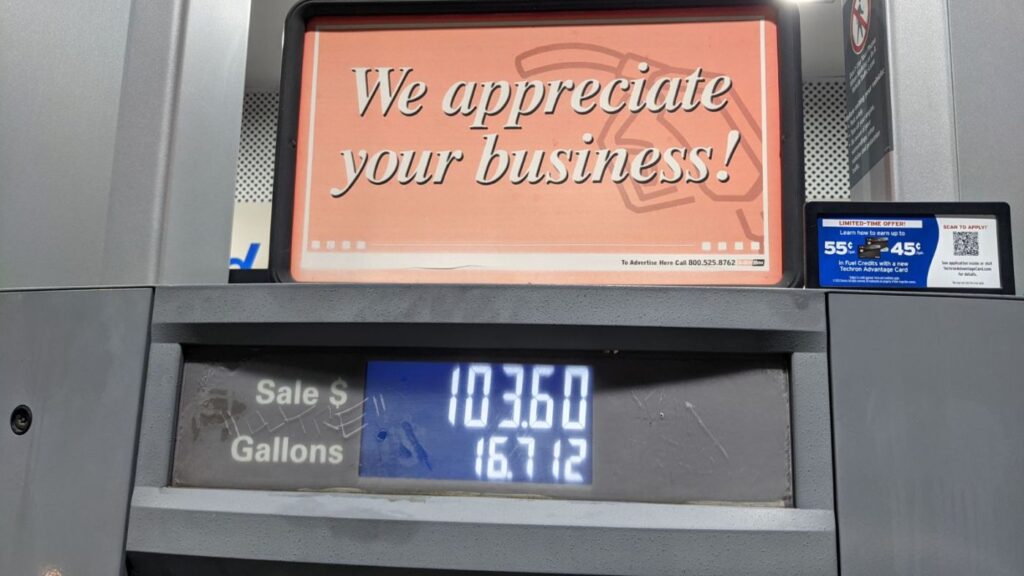
“Well, if you ever plan to motor west,” wrote songwriter Bobby Troup in 1964, “take my way, that’s the highway that’s the best. Get your kicks on Route 66.”
Today, he might write it differently.
“Well, if you ever plan to motor west, take the highway to the driveway of the bank.”
Here’s what it would cost you for regular-grade gas if you made that “Route 66” trip today from Chicago to St. Louis, Oklahoma City, Amarillo, Gallup, Flagstaff, don’t forget Winona, Kingman, Barstow, and San Bernardino:
The average price of regular-grade gas in Illinois on Tuesday was $3.61.
In Missouri, $3.27.
In Oklahoma, $3.19
In Texas, $3.01
In New Mexico, $3.51
In Arizona, $4.28
In California, $5.57
Of course, these are averages, and your neighborhood may vary. On Sunday in the San Fernando Valley, 16.7 gallons of regular gas cost me $103.60. I’ll do the math for you: $6.20 per gallon.
The cost of crude oil is the biggest driver of gasoline prices, but that doesn’t explain the cost differential as you go over state borders. Policy choices are the difference.
In California, a long list of policy choices are contributing to the high price of gasoline.
Even the worldwide price of crude oil is affected by California policy choices. The decisions to cut back oil production and import oil from other countries have an effect on supply and demand. In 1986, California production peaked at 402.23 million barrels of oil. That was 59.4% of all the oil that went to California refineries. That same year, foreign imports of oil to California totaled only 36.87 million barrels, just 5.5% of the oil refined in California. (The rest came from Alaska.)
Last year, after decades of grinding the domestic oil and gas industry with restrictions and lectures, oil production in California was down to 136 million barrels, or 25.8% of the oil refined in the state. Another 80.25 million barrels came from Alaska, and 311.53 million barrels were imported from countries including Saudi Arabia and Iraq. That’s 59% of the oil refined in California coming into the state from foreign sources instead of local production.
Even as recently as 2017, California’s local production provided 31.3% of the oil that went to California refineries. But there’s no sign that anyone in Sacramento would like to reverse the downward trend, so you can expect the grinding, the restrictions and the hypocritical lectures to continue.
Other policy choices contribute to the high price of gasoline in California, like the 58 cents per gallon in state taxes, on top of federal taxes. The most recent legislation raising gas taxes in the state also included an annual inflation adjustment, so when prices go up and inflation goes up, drivers get slammed twice.
California also requires refineries to buy permits for emitting greenhouse gases, part of a program run by the California Air Resources Board. This regulatory scheme adds varying amounts to the price of all energy in the state, and the money that’s paid for the permits goes into a fund in the state Treasury, just like a tax. Lawmakers decide how they’re going to spend the money, just like a tax. But the courts have said it’s not a tax.
That worked out well for the California High-Speed Rail Authority. The ballot measure that authorized the initial debt financing for the project prohibited any tax increase or public subsidy, but the boondoggle caught a break with the court ruling, because it meant the money you’re paying in the price of gasoline and diesel for these permits could be used to build the bullet train.
And that’s exactly what’s happening. Twenty-five percent of the revenue that goes into the Greenhouse Gas Reduction Fund is routed to the High-Speed Rail Authority to pay the high salaries of its executives, the paintings and animations used to show you how great it’s going to be, and the cost of constructing the infrastructure on the route that is definitely not San Francisco to Los Angeles.
Other factors, like smog-reduction regulations, also contribute to the cost.
It’s enough to make anyone who wants to motor west decide to make a U-turn.
Write [email protected] and follow her on Twitter @Susan_Shelley
